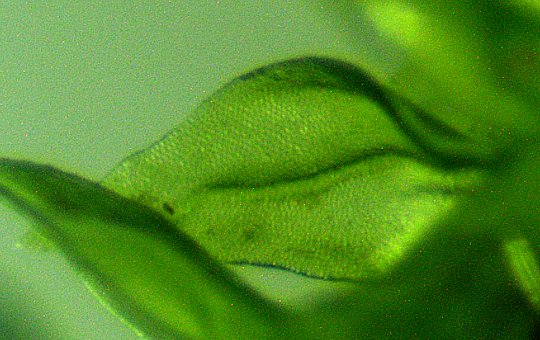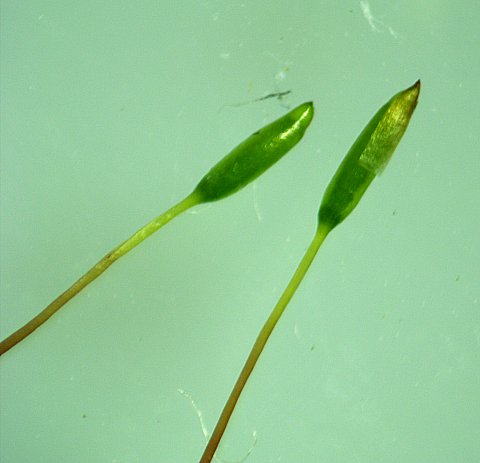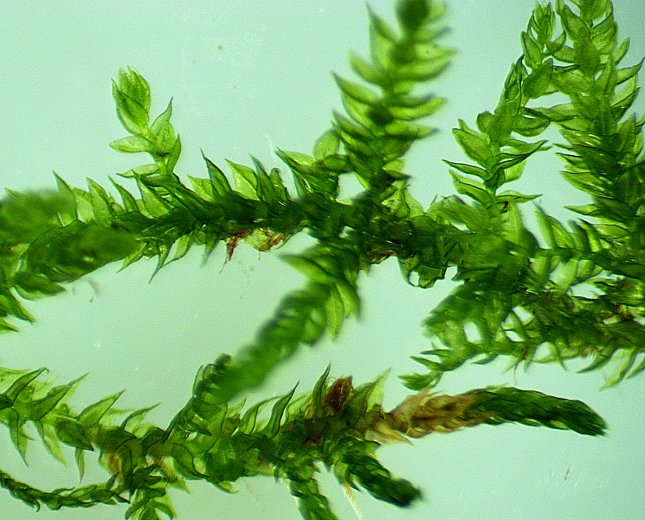
Spore-bearing capsules on slender stalks are produced once a year, usually during the spring. The stalks (setae) are 5-10 mm. long, light yellowish brown to dull red, terete, smooth, and more or less erect (relative to the orientation of the matted moss). The spore-bearing capsules are 1.5–2.5 mm. long and straight-cylindrical in shape; relative to their stalks, they are erect. They are light green while immature, becoming brown with age. The lid (operculum) at the apex of each capsule has a medium-conical shape; the lid and upper capsule are covered with a hairless membranous hood during an early stage of development; this hood has a long-conical beak. Eventually, the lid of each capsule falls off to release the tiny spores to the wind. Individual spores are 10-15 microns across, globoid in shape, and finely warty or bumpy. The teeth of the capsule are revealed after the lid falls off; they are relatively long (about 0.3 mm.), yellowish brown, narrowly triangular, slightly incurved, and arranged in pairs. This moss has fibrous rhizoids that enable it to cling to coarse surfaces.

Cultivation: The preference is light to deep shade, moist humid conditions, tree bark surfaces, and protection from prevailing winds. During hot dry periods with low humidity, this moss becomes dormant, but it resumes growth when cool temperatures, moisture and humidity return. There is some tolerance to urban and suburban air pollution if it is not too severe.
Range & Habitat: Graceful Chain Moss (Leskea gracilescens) is occasional to common throughout Illinois (see Distribution Map). It may occur in every county of the state. Outside of the state, this moss is widely distributed in eastern North America. Habitats include lower trunk bark of trees in woods and wooded ravines, bark of fallen trees in woods and ravines, rotting tree stumps in woods and other shaded areas, lower trunk bark of trees in swamps, bark of fallen trees in swamps, rotting tree stumps in swamps, lower trunk bark of trees in parks and picnic areas, lower trunk bark of trees at farmhouses, lower trunk bark of trees in urban and suburban residential areas, lower trunk bark of trees along roadsides, lower trunk bark of trees along rivers, bark of fallen trees along rivers, exposed roots of trees in various shaded habitats, shaded areas of asphalt and shingle roofs, and on rocks along spring runs in moist shaded areas.

The trees of these habitats are usually living, although sometimes they are dead. In Illinois, this moss has been found on such hardwood trees as ash, elm, hawthorn, pecan, willow oak, maple, hackberry and cottonwood. It also occurs on the trunk and branches of Eastern Red Cedar (Juniperus virginianus). This moss is somewhat weedy, often occurring in disturbed habitats, but it is also found in high quality natural areas.
Faunal Associations: This moss has been used as nesting material by the Carolina Chickadee (Andreas, 2010). This bird often selects mosses that grow on trees for this purpose as it rarely lands on the ground.
Photographic Location: Chief Shemauger Park and Busey Woods in Urbana, Illinois. Close-up photos were taken indoors with a microscope.

Comments: This is one of the most common mosses to be found on the bark of trees in Illinois. It often occurs on trees in residential areas. Graceful Chain Moss (Leskea gracilescens) has a stringy unattractive appearance when it is dry, but this moss becomes more luxuriant in appearance after significant rainfall. Other Chain Mosses (Leskea spp.) are less common in Illinois. One of them, Obtuse Chain Moss (Leskea obscura), is very similar in appearance, except its leaves have blunt tips and its spore capsules are slightly shorter and their conical lids are more short and blunt. Another species, Curved Chain Moss (Leskea polycarpa), has light green foliage, instead of dark green foliage, and its leaf tips are conspicuously curved in one direction. Another species, Southern Chain Moss (Leskea australis) which is restricted to the southern tip of Illinois, has even smaller leaves and shorter capsules. All of these species prefer to grow on trunk bark of hardwood trees. Other common names of Leskea gracilescens are Leskea Moss and Necklace Chain Moss.